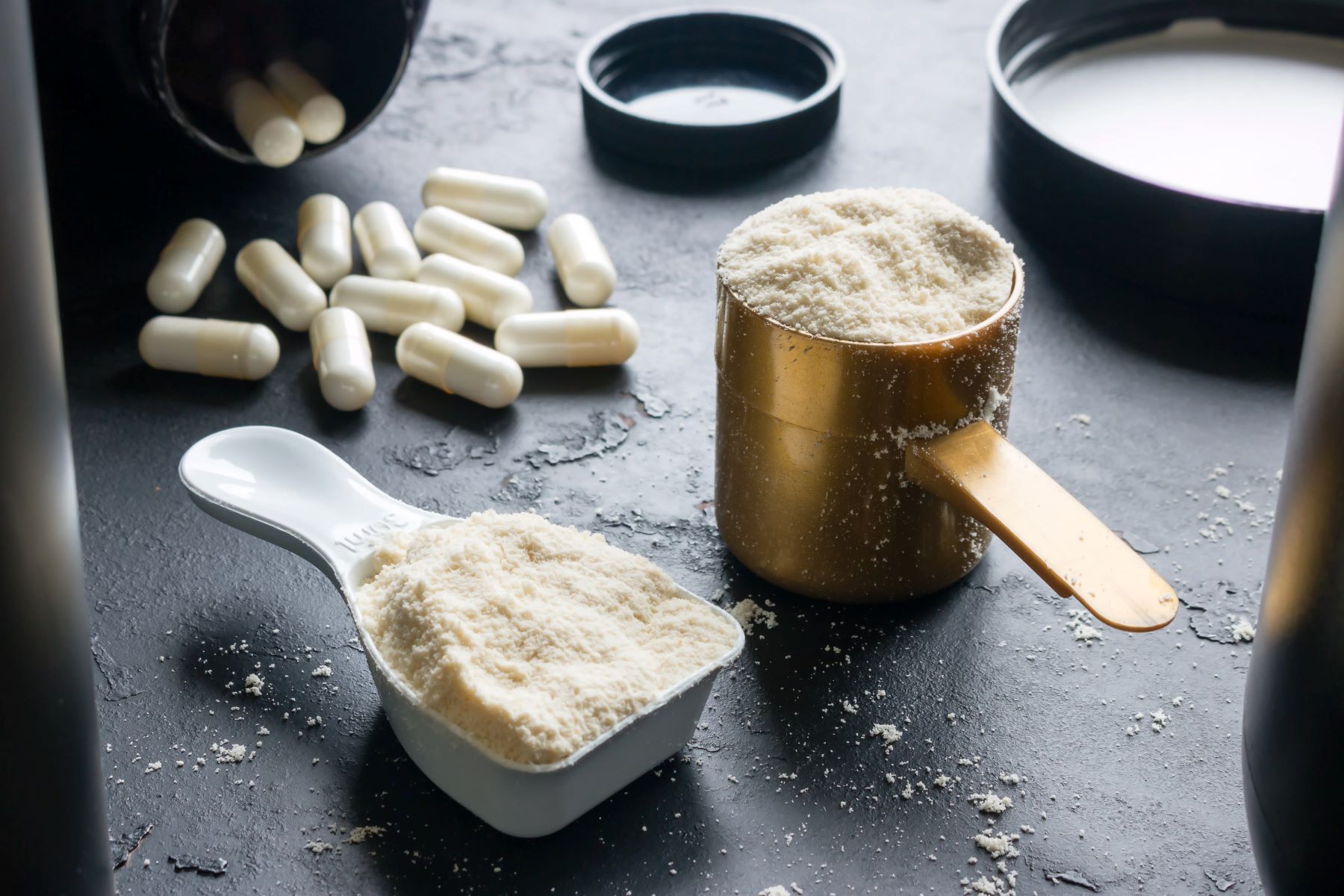

Featured
How To Avoid Lactic Acid In Triathlon
Modified: August 19, 2023
Learn how to prevent lactic acid build-up during triathlon races with our featured guide, packed with effective strategies and tips for optimal performance.
Introduction
Welcome to the world of triathlon, where athletes push their bodies to the limit in three demanding disciplines: swimming, cycling, and running. As a triathlete, you understand the importance of training, endurance, and mental strength to succeed in this grueling sport. However, there is one common adversary that can hinder your performance: lactic acid.
Lactic acid is a natural byproduct of intense exercise, produced when your muscles break down carbohydrates for energy without enough oxygen. As lactic acid accumulates in your muscles, it can lead to a burning sensation, fatigue, and a decline in performance. The buildup of lactic acid can make your muscles feel heavy and slow down your pace, making it harder to maintain the necessary speed and endurance for triathlon events.
While lactic acid is an inevitable part of intense physical exertion, there are strategies and techniques you can employ to minimize its impact on your triathlon performance. In this article, we will delve deeper into understanding lactic acid, explore its effects on triathlon performance, and provide you with valuable tips to avoid lactic acid build-up. By implementing these techniques, you can optimize your training, enhance your endurance, and achieve your best performance on race day.
Understanding Lactic Acid
Before we dive into strategies to prevent lactic acid build-up, let’s first gain a better understanding of what lactic acid is and how it affects our bodies.
Lactic acid, scientifically known as lactate, is a substance produced by our muscles during intense exercise. It is formed when our muscles break down glucose for energy in the absence of sufficient oxygen. This anaerobic process is necessary to fuel our muscles during high-intensity activities like sprinting or cycling uphill.
Contrary to popular belief, lactic acid itself is not responsible for the burning sensation in our muscles. Instead, it is the accumulation of hydrogen ions during the breakdown of glucose that causes the discomfort. Lactic acid is simply a byproduct of this process.
As lactic acid builds up in our muscles, it can contribute to fatigue, muscle soreness, and a decrease in performance. It can make our muscles feel heavy and affect our ability to sustain power and endurance. However, it is important to note that lactic acid is not inherently detrimental to our bodies. In fact, it can serve as an alternative fuel source for our muscles and has been found to have beneficial effects on aerobic metabolism.
Understanding lactic acid is crucial for triathletes because it allows us to appreciate the delicate balance between using it as a fuel source and minimizing its negative impact on our performance. By implementing effective strategies, we can optimize our training and ensure that lactic acid build-up does not hinder our ability to perform at our best.
Effects of Lactic Acid on Triathlon Performance
Lactic acid build-up can have a significant impact on your performance as a triathlete. Understanding these effects is crucial in order to develop strategies to mitigate its negative impact and optimize your performance during training and competition.
One of the most notable effects of lactic acid build-up is the onset of fatigue. As lactic acid accumulates in your muscles, you may experience a burning sensation accompanied by a feeling of heaviness and fatigue. This can significantly impair your ability to maintain a fast pace and sustain power output, ultimately slowing you down and affecting your overall race performance.
In addition to fatigue, lactic acid can also contribute to muscle soreness and stiffness. The acidic environment created by lactic acid can irritate nerve endings in your muscles, leading to increased discomfort and delayed recovery. This, in turn, can negatively impact your ability to perform at your best in subsequent training sessions or races.
Another effect of lactic acid build-up is the decrease in muscle contractility. Lactic acid can interfere with the ability of your muscles to efficiently contract and produce force. This can result in decreased power and a loss of explosive strength, crucial elements in disciplines such as sprinting or accelerating during a race.
Furthermore, the presence of lactic acid can impair your body’s ability to clear waste products and deliver nutrients and oxygen to your muscles. This can hinder muscle recovery and compromise the effectiveness of your training sessions. To optimize performance, it is essential to minimize the accumulation of lactic acid and improve your body’s ability to clear it out efficiently.
By being aware of these effects, you can tailor your training and preparatory strategies to minimize lactic acid build-up and maximize your performance in each leg of the triathlon. By implementing specific techniques, you can achieve a balance that allows you to push your physical limits while minimizing the negative impacts of lactic acid.
Tips to Avoid Lactic Acid Build-up
While lactic acid build-up is an inevitable part of intense exercise, there are several strategies you can employ to minimize its impact on your triathlon performance. By implementing these tips, you can optimize your training, improve your endurance, and enhance your race-day performance.
- Gradual Increase in Intensity: Gradually ramp up the intensity of your training sessions to allow your body to adapt and become more efficient at clearing lactic acid. Gradual progression will help minimize the build-up of lactic acid and improve your overall endurance.
- Breathing Techniques: Focus on deep diaphragmatic breathing during intense training sessions. This helps get more oxygen into your body, reducing the reliance on anaerobic metabolism and the subsequent production of lactic acid.
- Interval Training: Incorporate interval training into your workouts to increase your lactate threshold and improve your body’s ability to tolerate lactic acid. Alternating between high-intensity bursts and recovery periods can help train your muscles to clear lactic acid more efficiently.
- Proper Nutrition and Hydration: Maintain a balanced diet rich in complex carbohydrates, protein, and healthy fats to provide your body with the necessary energy for training and recovery. Stay properly hydrated to support optimal muscle function and lactic acid clearance.
- Warm-up and Cool-down: Incorporate dynamic warm-up exercises before your training sessions and races to increase blood flow and prepare your muscles for the demands of intense exercise. Afterward, perform a cool-down routine to aid in the removal of lactic acid and promote muscle recovery.
- Efficient Technique: Focus on maintaining proper form and technique during swimming, cycling, and running. Efficient technique reduces unnecessary muscle tension and helps minimize the production of lactic acid.
- Mental Strategies: Develop mental strategies to manage discomfort and push through the burning sensation caused by lactic acid build-up. Positive self-talk, visualization, and focusing on your race strategy can help distract from the discomfort and keep you mentally strong.
Implementing these tips will not only minimize lactic acid build-up but also contribute to improved overall performance. Remember, it is important to experiment and find the strategies that work best for you. Each triathlete is unique, and what works for one may not work for another. By fine-tuning your training and incorporating these tips, you can optimize your performance and achieve your triathlon goals.
Proper Nutrition and Hydration
Proper nutrition and hydration are essential elements in preventing lactic acid build-up and optimizing your performance as a triathlete. By fueling your body with the right nutrients and maintaining optimal hydration levels, you can enhance your endurance, improve your muscle function, and minimize the production of lactic acid.
One key aspect of nutrition for triathletes is ensuring an adequate intake of carbohydrates. Carbohydrates are the primary energy source for your muscles, providing the fuel needed to perform at high intensities. Aim to consume complex carbohydrates such as whole grains, fruits, and vegetables, as they provide sustained energy release and help prevent muscle fatigue and lactic acid accumulation.
In addition to carbohydrates, include lean proteins in your diet to support muscle repair and recovery. Protein helps maintain muscle mass, aids in the repair of damaged muscle tissues, and promotes optimal muscle function. Include sources such as lean meats, poultry, fish, beans, and legumes in your meals and snacks.
Fat is another important macronutrient to consider. While often feared, healthy fats are essential for hormone production and provide a concentrated source of energy. Include sources of unsaturated fats like avocados, nuts, seeds, and olive oil in your diet to support overall health and performance.
Hydration is equally vital for optimal performance and lactic acid management. Dehydration can impair your body’s ability to regulate temperature, deliver nutrients and oxygen to your muscles, and clear waste products, including lactic acid. Aim to drink regularly throughout the day and during your training sessions to maintain appropriate hydration levels.
During longer workouts or races, consider using sports drinks that contain electrolytes to replenish the minerals lost through sweat. Electrolytes, such as sodium and potassium, play a crucial role in muscle contractions and hydration balance.
To determine your fluid needs, it is important to listen to your body and monitor urine color and frequency. Pale yellow urine indicates proper hydration, while dark-colored urine may be a sign of dehydration. Develop a hydration plan that suits your body’s needs and adjust it based on environmental conditions and training intensity.
Remember, nutrition and hydration are not just limited to the hours leading up to and during training or competition. Consistently fueling your body with the right nutrients and maintaining optimal hydration throughout your daily life will contribute to improved performance and lactic acid management.
Consulting with a sports nutritionist or registered dietitian who specializes in endurance athletes can be beneficial in developing a personalized nutrition and hydration plan that meets your specific needs and goals. With proper nutrition and hydration, you can fuel your body efficiently, minimize lactic acid build-up, and optimize your triathlon performance.
Efficient Training Techniques
Efficient training techniques are crucial for triathletes looking to prevent lactic acid build-up and maximize their performance. By incorporating specific training methods into your routine, you can improve your body’s ability to tolerate lactic acid, enhance your endurance, and minimize fatigue.
One effective technique is interval training, which involves alternating periods of high-intensity exercise with recovery periods. This not only increases your lactate threshold but also trains your muscles to clear lactic acid more efficiently. Start with shorter intervals and gradually increase the duration and intensity as your body adapts.
Another technique is tempo training. This involves maintaining a steady pace just below your lactate threshold for an extended period. By improving your body’s ability to clear lactic acid while still exercising at a challenging intensity, you can enhance your endurance and delay the onset of fatigue.
Fartlek training, which means “speed play” in Swedish, is another effective method. It involves mixing bursts of high-intensity efforts with recovery periods. This type of training is versatile and can be tailored to suit your specific discipline. Incorporate short sprints or hills during your run, intervals with increased resistance on the bike, or faster paced laps during your swim.
It is also important to focus on sport-specific training. While cross-training is valuable, dedicating time to each individual discipline will improve your efficiency and technique. This, in turn, reduces unnecessary muscle tension and lactic acid production. Incorporate specific drills and workouts to refine your form and increase your overall efficiency in swimming, cycling, and running.
Variation in intensity is key to efficient training. Including recovery days and easy workouts alongside more intense sessions allows your body to adapt and recover without excessive lactic acid accumulation. Listen to your body and pay attention to signs of fatigue or overtraining, as pushing too hard can lead to increased lactic acid build-up and decreased performance.
Finally, it is important to prioritize rest and recovery. Adequate sleep and rest days are essential for muscle repair, growth, and lactic acid clearance. Recovery methods such as foam rolling, stretching, and massage can help alleviate muscle soreness and reduce lactic acid build-up.
Remember, efficient training techniques involve finding the right balance between intensity, volume, and recovery. It is important to have a structured training plan and seek guidance from a coach or experienced triathlete to ensure you are progressing safely and effectively. By incorporating these techniques into your training regimen, you can enhance your endurance, minimize lactic acid build-up, and perform at your best on race day.
Warm-up and Cool-down Strategies
Warm-up and cool-down strategies play a vital role in preventing lactic acid build-up and optimizing your performance as a triathlete. By incorporating these practices into your training routine, you can prepare your muscles for intense exercise, improve blood flow, and enhance lactic acid clearance.
Before starting any training session or race, it is essential to perform a dynamic warm-up. This involves a series of movements that gradually increase your heart rate, body temperature, and blood flow to the working muscles. Dynamic warm-ups typically include exercises such as jogging, high knees, leg swings, arm circles, and lunges. The goal is to activate the muscles, mobilize the joints, and prepare your body for the demands of the upcoming activity.
In addition to mobilizing exercises, include sport-specific movements in your warm-up routine. For swimming, perform some low-intensity laps or practice drills that mimic the strokes you will be using. For cycling, spin on the bike at a moderate pace or do some light resistance work. For running, start with a slow jog and incorporate dynamic movements such as butt kicks and leg swings.
The duration of your warm-up will depend on the intensity and duration of your planned workout or race. Aim for at least 10-15 minutes of dynamic movements and gradually increase the intensity as you warm up. Pay attention to how your body feels and make adjustments accordingly.
After completing your training session or race, it is equally important to cool down and allow your body to recover. Cooling down helps gradually lower your heart rate, remove waste products such as lactic acid, and promote muscle recovery.
A cool-down typically involves a combination of low-intensity exercises, stretching, and foam rolling. Slow down your pace and perform gentle exercises such as walking or slow jogging to gradually bring your heart rate back to normal. Follow this with a stretching routine that targets the major muscle groups used during your activity. Hold each stretch for 20-30 seconds and focus on breathing deeply to help relax the muscles.
Foam rolling, also known as self-myofascial release, can be another beneficial component of your cool-down routine. It helps release muscle tension, increase blood flow, and reduce post-exercise soreness. Roll along the muscle groups, applying gentle pressure to any tender or tight areas.
Implementing regular warm-up and cool-down strategies in your training routine will not only minimize lactic acid build-up but also reduce the risk of injury and improve overall performance. Make warm-up and cool-down an integral part of your training sessions, regardless of the intensity or duration. Your body will thank you for it.
Breathing Techniques
Breathing techniques are often overlooked but can have a significant impact on lactic acid build-up and overall performance during triathlon events. Proper breathing patterns can help increase oxygenation, improve endurance, and reduce the production of lactic acid.
One of the most effective breathing techniques is diaphragmatic breathing, also known as belly breathing. This involves utilizing the diaphragm, a muscle located at the base of the lungs, to draw air deep into the lungs. To practice diaphragmatic breathing, place one hand on your belly and the other on your chest. Inhale deeply through your nose, expanding your belly as you fill your lungs with air. Exhale slowly through your mouth, allowing your belly to deflate as you release the air.
Diaphragmatic breathing has several benefits for triathletes. Firstly, it helps increase the oxygen exchange in your lungs, supplying more oxygen to your working muscles. This reduces the reliance on anaerobic metabolism and minimizes the production of lactic acid. Secondly, it promotes relaxation and reduces muscle tension, allowing you to maintain an efficient and rhythmic breathing pattern throughout your performance.
Another useful technique is synchronization of breath with exercise movements. In swimming, sync your breathing pattern with your stroke, inhaling as your arm enters the water and exhaling as it exits. During cycling and running, coordinate your breath with your cadence, aiming to take full breaths during the easier portions and exhaling more forcefully during intense efforts.
While it is important to have a consistent breathing pattern, it is also crucial to adjust your breathing as needed during different training and race intensities. During high-intensity intervals or challenging climbs, you may find it beneficial to take shorter, faster breaths to meet the increased demands. However, during steady-paced segments, focus on deep, slow breaths to maximize oxygen intake and maintain a relaxed state.
Practicing breathing techniques during training sessions is vital to refine your technique and become comfortable with different patterns. Incorporate specific breathing drills into your workouts to improve oxygen efficiency and enhance lactic acid clearance. For example, you can try breathing on every third stroke during swimming to encourage a longer exhale and a more rhythmic breathing rhythm.
By implementing proper breathing techniques in your training and race preparations, you can optimize your oxygen intake, improve your endurance, and minimize lactic acid build-up. Remember to stay mindful of your breathing during intense moments and use it as a tool to remain calm and focused. With practice, breathing techniques will become second nature and contribute to your overall success as a triathlete.
Mental Strategies to Prevent Lactic Acid Build-up
While lactic acid build-up is a physical sensation, mental strategies can play a significant role in how we perceive and manage it during triathlon events. By employing specific mental techniques, you can reduce the discomfort associated with lactic acid build-up and perform at your best, even when pushing your limits.
One effective strategy is positive self-talk. By consciously directing your thoughts towards positive and supportive statements, you can shift your focus away from the discomfort and fatigue caused by lactic acid build-up. Use phrases such as “I am strong,” “I can push through this,” or “I am capable of handling the burn.” Repeating these affirmations can boost your confidence and mental resilience, helping you push through tough moments during the race.
Visualization is another powerful mental technique. By creating vivid mental images of yourself performing at your best, you can mentally rehearse how you want to handle lactic acid build-up during the race. Visualize yourself maintaining a steady pace, feeling strong and in control, and managing any discomfort with ease. This mental preparation can help reduce anxiety and enhance your ability to stay focused and positive during challenging moments.
Another helpful technique is focusing on your race strategy. By having a clear plan and breaking the race down into smaller, manageable segments, you can divert your attention away from the lactic acid build-up. Instead of fixating on the muscle burn, concentrate on executing your race strategy, such as maintaining an even pace or gradually increasing your effort. This shift in focus can help create a sense of purpose and control, minimizing the mental impact of lactic acid build-up.
Breathing exercises can also have a calming effect on both the mind and body. By maintaining a deep and rhythmic breath, you can help regulate your heart rate, reduce tension, and stay centered during moments of discomfort. Focusing on your breath can act as an anchor and allow you to detach from any negative sensations associated with lactic acid build-up.
Lastly, develop a mental attitude of acceptance and embracing the challenge. Acknowledge that lactic acid build-up is a natural part of intense exercise and a sign of pushing your limits. Embrace the discomfort as a reminder of your determination and the effort you are putting into your performance. By reframing the sensations as a positive indication of your physical and mental strength, you can transform lactic acid build-up into a catalyst for motivation and drive.
Experiment with different mental strategies during your training sessions to determine what works best for you. It is important to practice these techniques to strengthen your mental resilience and develop the ability to stay focused and positive during races. By incorporating these mental strategies, you can effectively manage lactic acid build-up and perform to the best of your abilities as a triathlete.
Conclusion
Lactic acid build-up is a common challenge faced by triathletes during intense training sessions and races. However, by implementing the right strategies, you can minimize its impact and optimize your performance.
Understanding lactic acid and its effects on your body is the first step towards developing effective prevention techniques. By implementing strategies such as proper nutrition and hydration, efficient training techniques, warm-up and cool-down routines, breathing techniques, and mental strategies, you can minimize lactic acid build-up and enhance your triathlon performance.
Proper nutrition and hydration ensure that your body has the necessary fuel and resources to perform at its best while minimizing lactic acid accumulation. Efficient training techniques, such as interval training and tempo training, can improve your body’s tolerance to lactic acid and enhance your endurance. Warm-up and cool-down routines prepare your muscles for intense exercise and aid in lactic acid clearance. Utilizing proper breathing techniques optimizes oxygen exchange and reduces lactic acid production. Finally, mental strategies such as positive self-talk and visualization help you manage discomfort and stay focused during challenging moments.
Remember, each triathlete is unique, and it may take some experimentation to find the strategies that work best for you. It is essential to listen to your body, seek expert guidance if necessary, and tailor your training and racing strategies accordingly.
By implementing these techniques and developing a comprehensive training plan, you can minimize lactic acid build-up, enhance your endurance, and achieve your goals in triathlon. The key is to strike a balance between pushing your limits and effectively managing the effects of lactic acid to optimize your overall performance and enjoyment of the sport.
As you continue your journey as a triathlete, embrace the challenges and use them as opportunities for growth and improvement. With dedication, proper training, and the implementation of these strategies, you can conquer lactic acid build-up and achieve your best performance on race day.









